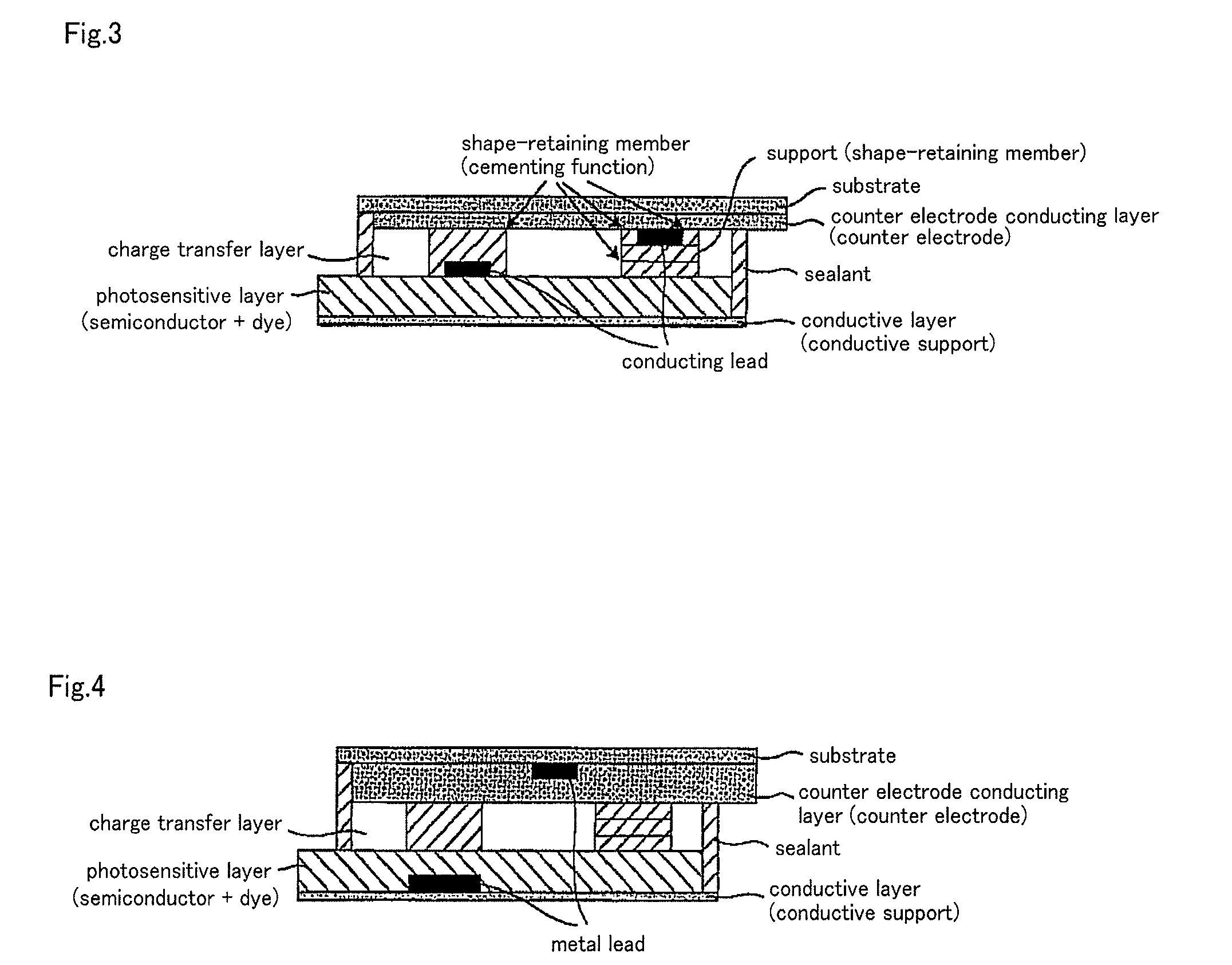Dye-sensitized type solar cell
a solar cell, dye-sensitized technology, applied in deferred-action cells, electrolytic capacitors, electrochemical generators, etc., can solve the problems of lapse solidification, lack of long-term reliability, deficient etc., to improve ionic conductivity and other performance characteristics, the effect of high safety
Inactive Publication Date: 2012-02-28
NIPPON SHOKUBAI CO LTD
View PDF13 Cites 9 Cited by
- Summary
- Abstract
- Description
- Claims
- Application Information
AI Technical Summary
Benefits of technology
The present invention provides a dye-sensitized solar cell with improved safety, ionic conductivity, and cell performance. This is achieved by using a molten salt with no flash point, which eliminates the need for hermetic sealing. The use of an inonic substance with a defined anion structure as the molten salt reduces viscosity in the electrolyte and enhances ionic conductivity, resulting in improved cell performance. The dye-sensitized solar cell comprises an ionic substance represented by a specific formula.
Problems solved by technology
Such solar cells use an organic solvent as the electrolysis solvent and, partly because of the drawback that the ready volatility and flash point of the solvent call for hermetic sealing and partly because of the high incidence of leakage leading to lack of long-term reliability and deficiencies in safety, there has been a standing demand for a constituent material with which such drawbacks could be overcome.
However, the former complex presents with corrosion problems due to halide ions while the latter is a supercooled liquid which is thermodynamically unstable and, hence, presents with the problem of solidification with the lapse of time.
However, these are deficient in ionic conductivity and other performance characteristics and, moreover, since they contain fluorine, electrode corrosion and other problems are inevitable.
However, none of these technologies have been shown to be applicable to the charge transfer layer of a dye-sensitized solar cell, and there is room for contrivance for providing a dye-sensitized solar cell not requiring a hermetic seal around the charge transfer layer and, hence, of high safety through substitution of a novel vehicle for the conventional electrolysis solvent such as acetonitrile in the charge transfer layer.
Method used
the structure of the environmentally friendly knitted fabric provided by the present invention; figure 2 Flow chart of the yarn wrapping machine for environmentally friendly knitted fabrics and storage devices; image 3 Is the parameter map of the yarn covering machine
View moreImage
Smart Image Click on the blue labels to locate them in the text.
Smart ImageViewing Examples
Examples
Experimental program
Comparison scheme
Effect test
example
[0133]The energy conversion efficiency η in the case where EMImDCA was used in the charge transfer layer was:
[0134]Energy conversion efficiency η=1.1%
the structure of the environmentally friendly knitted fabric provided by the present invention; figure 2 Flow chart of the yarn wrapping machine for environmentally friendly knitted fabrics and storage devices; image 3 Is the parameter map of the yarn covering machine
Login to View More PUM
 Login to View More
Login to View More Abstract
The present invention provides a dye-sensitized solar cell of high safety, of improved ionic conductivity, and, therefore, of excellent cell performance.The present invention is related to a dye-sensitized solar cell comprising an ionic substance having an anion represented by the following general formula (1):(wherein X represents at least one element selected from among B, C, N, O, Al, Si, P, As, and Se. M1 and M2 are the same or different and each represents an organic linking group. Q represents an organic group. a is an integer of not less than 1, and b, c, d, and e each is an integer of not less than 0).
Description
TECHNICAL FIELD[0001]The present invention relates to dye-sensitized solar cells. More particularly, it relates to a dye-sensitized solar cell comprising a molten salt as its charge transfer layer (electrolyte).PRIOR ART[0002]Recent solar cells are sealed cell structures and, among these, the dye-sensitized solar cell equipped with a semiconductor layer (photosensitive layer) which comprises a photosensitive substance such as titanium dioxide carrying a photosensitizing dye as adsorbed thereon is attracting attention because of its high photo-electric energy conversion efficiency. The dye-sensitized solar cell, for example of the construction illustrated in FIG. 7, comprises a conductive support, such as Fluorine-doped Tin Oxide(FTO), a photosensitive layer (a semiconductor layer containing a photosensitive substance) which contains a finely divided semiconductor such as TiO2 particles sensitized by a dye such as ruthenium-2,2-bipyridine (Ru-bpy), a charge transfer layer comprising ...
Claims
the structure of the environmentally friendly knitted fabric provided by the present invention; figure 2 Flow chart of the yarn wrapping machine for environmentally friendly knitted fabrics and storage devices; image 3 Is the parameter map of the yarn covering machine
Login to View More Application Information
Patent Timeline
 Login to View More
Login to View More Patent Type & Authority Patents(United States)
IPC IPC(8): H01L31/00H01G9/20H01L51/30
CPCH01G9/2013H01G9/2031H01G9/2059Y02E10/542
Inventor MIZUTA, KEIICHIRONAKAMURA, JUNICHI
Owner NIPPON SHOKUBAI CO LTD
Features
- R&D
- Intellectual Property
- Life Sciences
- Materials
- Tech Scout
Why Patsnap Eureka
- Unparalleled Data Quality
- Higher Quality Content
- 60% Fewer Hallucinations
Social media
Patsnap Eureka Blog
Learn More Browse by: Latest US Patents, China's latest patents, Technical Efficacy Thesaurus, Application Domain, Technology Topic, Popular Technical Reports.
© 2025 PatSnap. All rights reserved.Legal|Privacy policy|Modern Slavery Act Transparency Statement|Sitemap|About US| Contact US: help@patsnap.com



